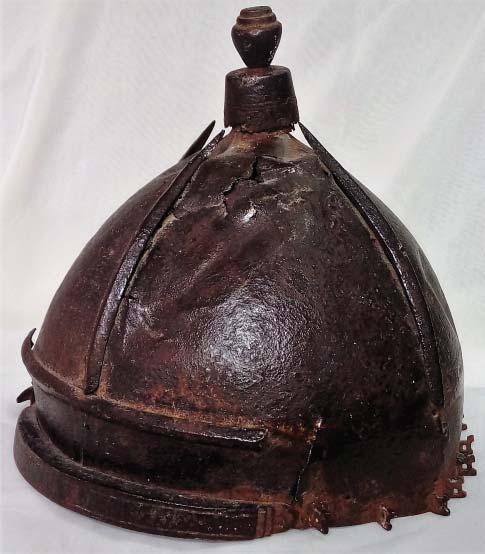OIRAT WARRIOR'S HELMET FROM THE AKMOLA REGIONAL HISTORY MUSEUM COLLECTION
DOI:
https://doi.org/10.24852/2587-6112.2020.6.393.404Keywords:
Kazakhstan, the Oirats, the Dzhungars, the Kalmyks, Oirat armour, Oirat helmetAbstract
The article provides a detailed analysis of a riveted iron helmet (GIN 148) deposited in the Akmola Regional History Museum (ARHM), Kokshetau, the Republic of Kazakhstan. Initially the helmet was identifi ed as "Russian" by Kazakhstan researchers, and subsequently reclassifi ed as "Kazakh". A typological analysis conducted by the authors has provided more precise dating and attribution of the helmet. The helmet belongs to the class of iron helmets in terms of material, to the riveted class in terms of crown design, and to the spheroconical type in terms of the dome shape. Its total height is 24.5 cm, and the diameter is 21.0 cm. It has been confi rmed that the helmet GIN 148 belongs to a special group of helmets of the Oirat-Kazakh borderland of the late Middle Ages or the early Modern times. Currently 18 similar helmets have been identifi ed by researchers, which originate from the territory of Kazakhstan, Mongolia, Russia (Volga region, Southern Siberia) and North-Western China. A distinctive feature of this series of helmets is a riveted four-plate crown supplemented by a "carcass" consisting of narrow overlays with a fl at edge and a narrow hoop (or two hoops) fi tted much higher than the bottom edge of the helmet. An analysis of the A-shaped chain mesh fi xers revealed that they can be attributed to the image of the Sanskrit syllables "ma" (written in Lancha letters), traditionally included in many Buddhist mantras. Images of the Sanskrit signs "ma", "om", etc. have been found on numerous protective weapons of Oirat manufacture (helmets, shells, etc.) dated the 17th - mid-18th centuries and deposited in Russian and foreign museum and private collections. Specifi c features of the helmet from the Aktobe Regional Museum of History and Local Lore as well as Buddhist symbols in its design indicate that this headpiece was crafted by Oirat (Jungar or Kalmyk) armourers in the 17th– mid-18th centuries. It is very likely that the helmet could have subsequently fallen into the hands of Kazakh nomads and could been used as a headpiece until the mid-19th century.
References
Anisimova, M. A. 2013. Oruzhie Vostoka XV – pervoi poloviny XX veka: iz sobraniia Voenno-istoricheskogo muzeia artillerii, inzhenernyh vojsk i vojsk svjazi (Weapons of the East of the 15th - First Half of the 20th Centuries: from the Collection of the Military-Historical Museum of Artillery, Engineer and Signal Corps). Saint Petersburg: “Atlant” Pub. (in Russian).
Akhmetzhan, K. S. 2015. Boevye shlemy kazakhov (istoriia, istoki, traditsii) (Battle Helmets of the Kazakhs (History, Origins, Traditions). Astana (in Russian).
Bobrov, L. A. 2009. In Vestnik Novosibirskogo Gosudarstvennogo universiteta. Istoriia, fi lologiya (Bulletin of the Novosibirsk State University: History, Philology) 8 (3), 251–254 (in Russian).
Bobrov, L. A. 2011. Osnovnye napravleniia evoljutsii kompleksov zashchitnogo vooruzheniia narodov Central'noi, Srednei i kontinental'noi Vostochnoi Azii vtoroi poloviny XIV– XIX vv. (Main directions in the Evolution of the Complexes of Protective Weapons of the Peoples of Central, Middle and Continental Eastern Asia in the Second Half of the 14th - 19th cc.) Thesis of Diss. of Doctor of Historical Sciences. Barnaul (in Russian).
Bobrov, L. A., Kushkumbaev, A. K. 2010. In Akmolinskomu oblastnomu istoriko-kraevedcheskomu muzeyu 90 let (The 90st Anniversary of Akmola Regional Museum of Local History). Kokshetau: Aqmola regional historical museum, 33–38 (in Russian).
Bobrov, L. A., Ozheredov, Yu. I. 2010. In Ozheredov, Yu. I. (ed.). Materialy i issledovaniia drevnei, srednevekovoi, i novoi istorii Severnoi i Tsentral’noi Azii (Materials and Studies on the Ancient, Medieval and Modern History of Northern and Central Asia) III. Tomsk: Tomsk State University, 7–64 (in Russian).
Bobrov, L. A., Ryumshin, M. A. 2015. In Mirgaleev, I. M. (ed.). Zolotoordynskaia tsivilizatsiia (The Golden Horde Civilization) 8. Kazan: “Foliant” Publ.; Institute of History named after Sh. Mardzhani, Tatarstan Academy of Sciences Publ., 357–378 (in Russian).
Bobrov, L. A., Khudyakov, Yu. S. 2008. Vooruzhenie i taktika kochevnikov Tsentral'noy Azii i Yuzhnoy Sibiri v epokhu pozdnego srednevekov'ya i rannego Novogo vremeni (XV – pervaya polovina XVIII v.). (Armament and Tactics of the Central Asian and South Siberian Nomads in the Late Middle Ages and the Early Modern Time (15th - fi rst half of 18th cc.). Saint Petersburg: Faculty of Filology, Saint Petersburg State University (in Russian).
Bobrov, L. A., Khudyakov Yu. S. 2011. In Rakhimzyanov, B. R. (ed.). Srednevekovye tiurko-tatarskie gosudarstva (Medieval Turkic-Tatar States) 3. Kazan: “Ikhlas” Publ., 43–52 (in Russian).
Gorelik, M. V. 1983. In Rybakov, B. A. (ed.). Kulikovskaya bitva v istorii i kul'ture nashey Rodiny (The Battle of Kulikovo in the History and Culture of our Country). Moscow: Moscow State University Publ., 244–269 (in Russian).
Zlatkin, I. Ya. 1983. Istoriia Dzhunfarskogo khanstva (1635–1758). (History of the Dzungarian khanate (1635-1758)). Moscow: “Nauka” Publ. (in Russian).
Kozybaev, M. K. (ed.). 1996. Natsional’no-osvoboditel’naia bor’ba kazakhskogo naroda pod predvoditel’stvom Kenesary Kasymova (National Liberation Struggle of the Kazakh People Led by Kenesary Kasymov). Almaty: “Gylym” Publ. (in Russian).
Tepkeev, V. T. 2012. Kalmyki v Severnom Prikaspii vo vtoroi treti XVII veka (The Kalmyks in the Northern Caspian Region in the Second Third of the 17th Century). Elista: “Dzhanfar” Publ. (in Russian).
Tsyuryumov, A. V., Batyrov, V. V. 2006. Kalmytskoe khanstvo v rossiisko-krymskikh otnosheniiakh (XVIII v.). (Kalmyk Khanate in Russian-Crimean Relations (18th c.)) Elista (in Russian).
Chimitdorzhiev, Sh. B. 1979. Vzaimootnosheniia Mongolii i Srednei Azii v XVII–XVIII vv. (The relationship between Mongolia and Central Asia in the 17th-18th cc.) Moscow: “Nauka” Publ. (in Russian).
Bobrov, L. A., Zaytsev, V. P., Orlenko, S. P., Salnikov, A. V. 2017. In Bylye gody (Bygone Years) 4 vol. 46, 1140–1173 (in English).
LaRocca, D. 2006. Warriors of the Himalayas. Rediscovering the Arms and Armor of Tibet. New York: Yale University Press (in English).

Downloads
Published
How to Cite
Issue
Section
License
Copyright (c) 2020 L.A. Bobrov, A.K. Kushkumbaev

This work is licensed under a Creative Commons Attribution-NonCommercial 4.0 International License.







